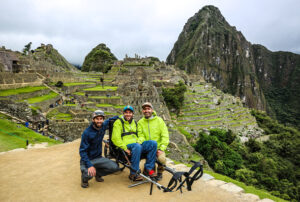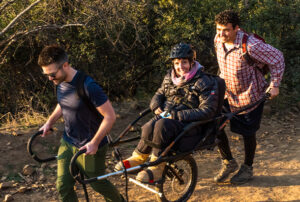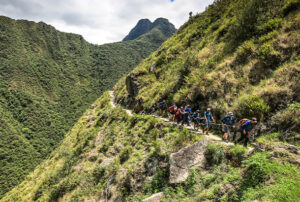A car accident left Alvaro Silberstein thinking he might never hike again. Instead, he founded Wheel the World to help people with disabilities climb to previously unattainable heights
A hiker on the W Trek through Chile’s Torres del Paine National Park will see soaring granite spires, rugged steppes, and colossal glaciers that slip into gem-colored lakes. To complete all five days on this iconic Patagonian trail in the southernmost Andes is considered a rite of passage for athletic Chileans, and it was a childhood dream of Alvaro Silberstein, who spent his youth as one of Santiago’s most promising rugby players.
That dream seemed to die in 2004, when a drunk driver blitzed through solid yellow lines into oncoming traffic, crashing into Silberstein’s car and leaving him paralyzed from the chest down. In the years that followed, he came to view the W Trek as a symbol of what he had lost.

“For many years, I saw it as an impossible dream,” Silberstein recalls today, sitting in his office in Santiago, just one block from where the life-changing accident occurred. Yet, a decade later, as he started to test the limits of his capabilities and regain confidence in his body, he and his childhood friend Camilo Navarro began searching for a way to undertake that deferred adventure. “We realized nobody had done the trail in a wheelchair before,” Silberstein says, “so we decided to transform that trip into a project.”
Their goal was to help Silberstein, who was then working on an MBA at UC Berkeley’s Haas School of Business, become the first person with quadriplegia to complete the W Trek. Silberstein and Navarro raised money to purchase a lightweight, one-wheeled hiking wheelchair, designed by the French company Joëlette, that can traverse rough terrain with the help of two assistants. In 2016 they completed the hike, a feat that was documented by a camera crew in the award-winning short film Adventure Is for All. Silberstein and Navarro even trained local tour operators in how to use the wheelchair, leaving it behind after they were done.
“That trip totally changed my perspective and my confidence on what things I could achieve,” Silberstein says. It also made headlines in California, and soon queries came pouring in from families wanting to replicate the adventure.
“We realized that there were a lot of people also wishing that the travel industry would be more inclusive and more accessible for people with disabilities,” Silberstein says. So, in 2018, he and Navarro cofounded Wheel the World, now the world’s largest adventure travel company for thrill-seekers of differing abilities, to make the planet’s wildest places more inclusive for the very people who are most often excluded.

It’s an unseasonably warm day in August (Chilean winter) when Silberstein drives me in his hand-controlled SUV through the snarled traffic of Santiago’s eastern suburbs to the trailhead for Cerro Las Varas, a 4,000-foot summit in the Andean foothills just outside the city. Here, we meet a Wheel the World support team who are already busy assembling Joëlette hiking wheelchairs for their boss and two guests: Dani, a 50-year-old woman with quadriplegia, and Sami, a 10-year-old boy with cerebral palsy. Today is the first adaptive hike for Dani or Sami, and the excitement is palpable.
Soon, three teams are rolling the wheelchairs along a rugged trail. I offer my help as the front-end support person for Dani, while her adult son takes the rear. Together, we try to maintain Dani’s equilibrium while powering the chair forward as one collective unit. Condors circle in the sky overhead, and as we climb toward them, Dani tells me of all the hiking trips she and her son used to take, before she lost her ability to walk about a decade ago. “I can’t tell you how special it is,” she says, “to do this again, with my son by my side.”
The sky is radiant, the air bone-dry as we navigate lumpy hills blanketed in prickly shrubs and perky cacti. Other than a brief section shaded by spindly algarrobo trees, the route is raw and exposed. In the snowy peaks of the Andes above, skiers carve turns at the Farellones Resort, where Silberstein has since helped to open one of South America’s first adaptive ski schools.
Mountains like this are, of course, not made for wheelchairs—no matter how all-terrain the equipment may be. Our three-person unit must be deliberate and methodical, employing extra levels of problem-solving at every turn. The deeply rutted path requires careful route planning the likes of which the other hikers who pass by likely never have to consider.

On one particularly steep hill, the entire support team has to work together to ensure a safe summit for each wheelchair user. Operating in pairs on either side of the chairs, we push from below and pull from above to hoist them up the rocky, near-vertical slope. One small slip from anyone on the support team could send all of us tumbling downward in a jumble of dust and limbs. I can see why the wheelchair users wear helmets.
Facing and overcoming these challenges, however, builds a strong sense of community among the support team and the hikers. In particular, Silberstein notes that the experience helps those in the wheelchairs build confidence and trust, as they have to be willing to put their lives in the hands of the people to their front and rear.
When we arrive at the hilltop lookout after the 90-minute ascent, there’s a feeling of collective pride. A wooden cross with a small Virgin Mary statue at its base marks the end of the trail, and we stand around it, gazing at the skyscrapers of Chile’s capital as the setting sun bathes them in an amber glow. Sami peers over the ledge with a grin. “El cabro lo está pasando chancho,” whispers his proud father; literally, this translates to “The goat is going pig,” but I know that in Chile’s animal-heavy Spanish slang it means, “The kid is having an amazing time.” This is Sami’s first time seeing the city glisten from the hills above, and the joy he exhibits is so raw it spreads throughout the entire group.
As Silberstein takes it all in, he tells me how much impact an experience like this can have for people like Dani and Sami. “They realize that they shouldn’t limit themselves, and that the tough things they have gone through in the past are possible to accept and turn into a learning experience,” he says. “It’s really quite an emotional experience.”
Silberstein is motivated to help others have such experiences in part because of how much his own excursions aided in his recovery. Following his initial trek in Patagonia, he pioneered trips into Chile’s Atacama Desert using hand-cranked bikes (for those who may have spinal cord injuries) and recumbent bikes (for those who may have had a stroke). He brought equipment to Rapa Nui (Easter Island) and trained local guides in how to lead adaptive bike trips to the island’s monolithic moai statues and adaptive scuba dives with amphibious wheelchairs that offer a seamless transition from beach to water.
“Part of my rehabilitation and gaining confidence in myself was thanks to these kinds of adventures,” Silberstein says. “We all deserve to have access to recreation, to adventure, and to nature.”

Silberstein’s personal crowning achievement was tackling the Inca Trail in Peru. He calls the hike “the best experience of my life,” although the undertaking was so arduous that he deemed it unsafe to promote and scale. That didn’t stop him, however, from starting a program at the trail’s ultimate destination: In 2018, Wheel the World equipped tour guides at Machu Picchu with adaptive wheelchairs and the necessary training to make its jungle-clad hilltop ruins accessible to people with disabilities for the first time.
Since then, Wheel the World has expanded to 98 destinations in 26 countries, adding adaptive activities such as kayaking in California, surfing in Maui, caving in the Yucatán Peninsula, zip-lining in Costa Rica, going on safari in South Africa, and paragliding along the Chilean coast. The company is also expanding beyond adventure, into leisure travel and hotel bookings, crowdsourcing data on its new Accessibility Mapping System to provide travelers with information they won’t find on traditional booking websites, such as the width of doors, height of beds, and types of showers available, as well as whether or not staff have received any training to prepare for guests with disabilities. By the end of 2021, Wheel the World had more than tripled its listings, from 250 to 800, reaching further into the U.S., Canada, and Europe to bolster its already strong presence in Latin America.
“This will not be a sprint,” Silberstein says. “It’s a marathon that we will continue doing to allow people to find their accessible experience anywhere they want to go—anywhere in the world.”
Next Up: Ryan Sandes Sets the Ultimate Trail-Running Challenge in South Africa




